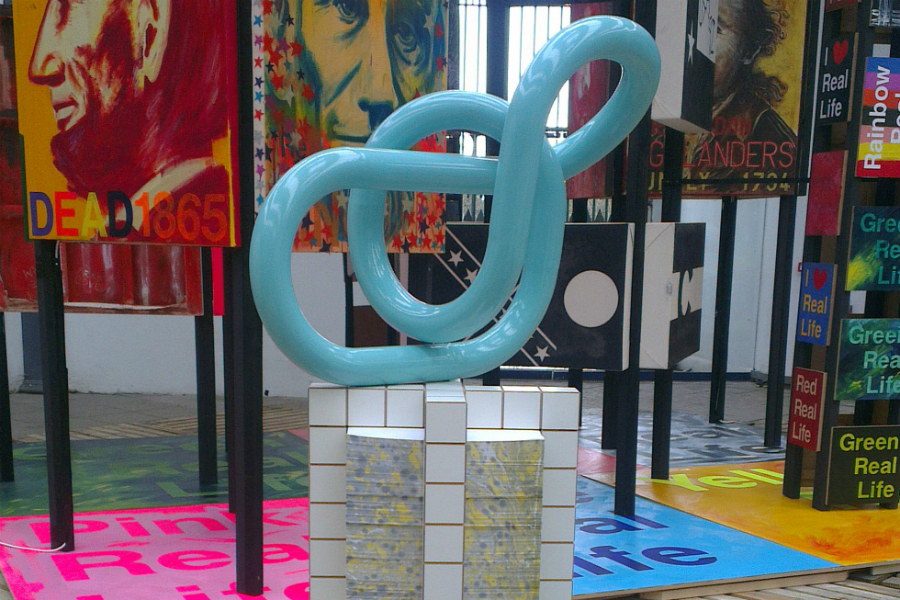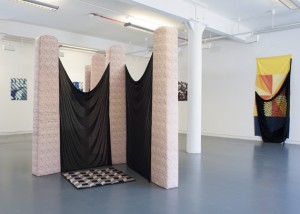In Conversation: Helen de Main and James McLardy

What is it really like to work within the ‘Glasgow Miracle’? Anna Taylor catches up with two artists working within the city’s artistic community…
Graduates of Glasgow School of Art, regular exhibitors at Glasgow International Festival, and affiliated with both the city’s print and sculpture studios, you could say that Helen de Main and James McLardy are embedded in the Glasgow art scene.
I first met De Main in Sheffield and where she was involved in many collaborative projects as a studio holder at S1 Artspace, and know them both through their international collaborations.
De Main had her first solo show last year – Dreams, Ideas, Actions at Glasgow Project Room — and has recently been involved in the production of 21 Revolutions at the Glasgow Women’s Library – commissioning 21 female artists and writers within the city to produce a book in response to its collections. McLardy is currently showing work in Reclaimed – The Second Life of Sculpture and is currently producing new work for a forthcoming show at Glasgow Sculpture Studios, Mood Is Made / Temperature Is Taken, curated by poet and critic, Quinn Latimer.
I caught up with the pair during Glasgow International to assess what it’s like to work in the former Capital of Culture.
What is your take on this year’s Glasgow International festival? What themes can you see emerging and how does this incarnation differ from previous years?
Helen de Main: I think that materially it feels different – there’s more video and digital work than in previous years. And there’s also a lot on gender and sexuality – male, queer sexuality, and a bigger representation of women.
James McLardy: It seems like there are a lot of female curators in the city at the moment and I celebrate the more matriarchal influence. I’m not sure whether this is a UK-wide phenomenon, but I’ve been more conscious of it here in recent times. The objects I made as offerings for the firing have both genders, they are hermaphrodite – so what does that say?
And do you think the way that GI is using spaces in the city differs this year? Are there fewer projects in remote or disused locations?
JMcL: It seems that over time, there are less disused spaces being used. I think that GI in the early days was very much that you’d go round with a man from the council with a bag of keys to look at potential spaces and things really built from the context of those spaces. Perhaps this is in-part to do with changes in the way the council is dealing with disused spaces.
HdM: It definitely seems that there has been a shift in the availability of spaces. We did a project for the last GI and it took a lot of negotiating to find a space – no one wanted to give spaces in advance in case they could let them out commercially. But as the festival gets more organised then there are pressing marketing deadlines further ahead, so venues need to be confirmed earlier, so perhaps these feed into each other.

GI is one of the UK’s biggest arts festivals and the city has a thriving and significant community of artists. What do you think are the factors that have enabled Glasgow to nurture the festival, and support the retention of its artists and graduates?
JMcL: I think there are so many different factors – people talk about the ‘Glasgow miracle’ as being to do with the art school, but I think there are other factors, like geography; the fact that it takes a long time to get from Glasgow to London, and that historically it is a very distinct place. Scotland is a clearly different country, which really helps. I’ve also seen other cities potentially struggling with proximity to the mega capital context, London. So things are incidental, geographic and social.
But there’s also a proud history of collaboration and collectivism whereby, like at Openaries, you really feel that you’re amongst a group of friends, and that seeing another artist’s performance enriches your understanding of that community, in a way that personally I haven’t experienced elsewhere.
Yes, this collective aspect is interesting – the generosity and openness of the performances seemed to give an alternative insight into the social aspect of making work in the city – there is a unique provision here that links to this – for example Glasgow Sculpture Studios and the Glasgow Print Studios…
HdM: Yes, these are significant places in the city that support the development of new strands in people’s practice – it perhaps also explains why so many artists here are still making things by hand. I learnt to screen print at the studio and this lead to a massive shift in the materiality of my practice. I have a studio at home, which can become quite isolating, so I really enjoy working at the print studio in tandem, as you encounter other artists and there is the possibility of chatting about what you’re working on.
We have seen a lot of text and spoken contributions at Openaries – is this something that is perhaps quietly taking place around the festival, for example, Sue Tompkins performance at GoMA?
HdM: Yes, it does seem that there are a lot of artists working with text in a variety of different media, that perhaps forms a core of their practice; be that Sue Tompkin’s small type written 2-D works, or Charlotte Prodger recording audio works, or people like Ruth Barker and Kathryn Elkin, each using the written word in a variety of different ways.
JMcL: I’m thinking about a commonality with all the artists mentioned, there’s something in their use or manipulation of the personable voice. I’m curious about what kinds of questions that brings out. They are all individual stories, lives and reflections.
Does this say something more general about the authorship of the festival – does this lie in many places, and is it coming from within the city’s art community or outside?
HdM: I think that Sarah McCrory has put together an interesting Director’s Programme that has a coherency to it. But outside of that the festival structure is quite open. Existing galleries can propose projects they want to do and then they get money through GI to put those projects on. And there are a number of alternative spaces in which artists or curators have proposed projects, so there is a nice diversity of voices coming through. It’s not like a biennial that has one over-arching voice or team of people curating. But I wonder whether there have been less of the smaller projects — it seems like maybe there are.
There is such a lot of work in organising these and sometimes the desire to do something creative gets overwhelmed by all the bureaucracy – that could be why Openaries worked well, because it uses existing venues and structures, leaving enough space for its creativity to breath.
We have spoken about openness, a diversity of voices, collective experiences and coherence — what is the role or impact of GI in reflecting and supporting the city’s artists as individuals and as a community?
JMcL: I guess there’s a context thing, this question is ongoing – how we all interlink and how the city connects. It makes us conscious of the positive and negative aspects of our community, and that is a rare thing. It is located within this art community, which is affirming and enriching. And yet during it, especially at the start, you get an overload of PR, which makes you question a lot of things, whether you fit in, but towards the end of it you almost always think ‘well, I’m just part of the bigger picture’ and each GI you get to fit in in a different way.
Anna Taylor
Anna Taylor is a writer based in West Yorkshire and works at Redeye, Manchester
Images: main: James McClardy at GI 2014 (image courtesy Frances Disley). Centre: Helen de Main, Dreams, Ideas, Actions. Glasgow Project Room 2013
See James McLardy’s work in Reclaimed – The Second Life of Sculpture, until 2 May 2014 at Wasp Artists’ Studios: The Briggait, free entry. We spoke to him back in 2012 during CAVE Art Fair — see here
Post-Glasgow International festival exhibitions continue at various venues across Glasgow, including Gabriel Kuri: All Probability Resolves into Form (7 June 2014) and Aleksandra Domanović (1 June 2014) – see here for full programme
See our GI Highlights here





